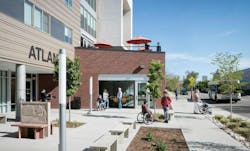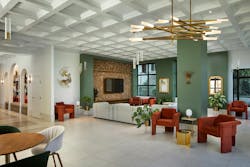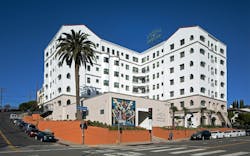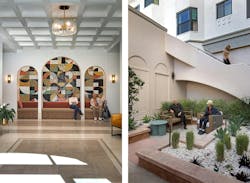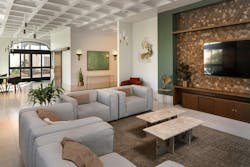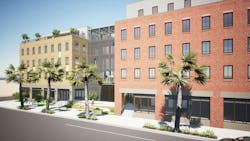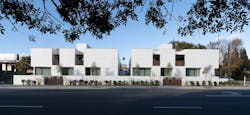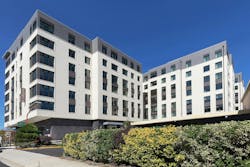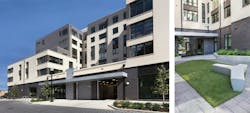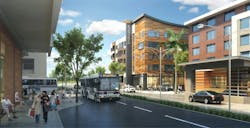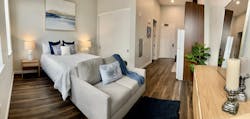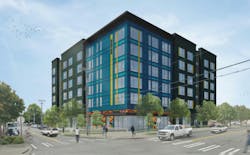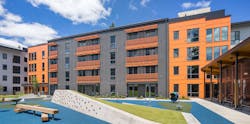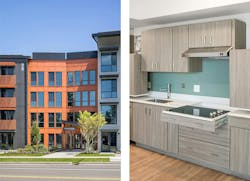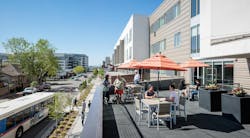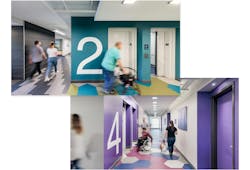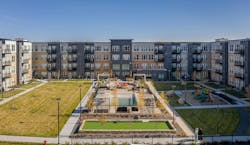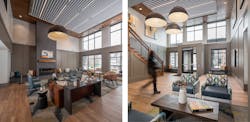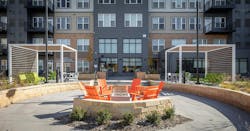These 9 novel housing communities offer support beyond affordability
In our latest call for entries, Building Design+Construction collected over 20 multifamily projects with a focus on affordable housing. Affordability goes hand in hand with supportive housing, whether it be senior living, veteran assistance, or housing focused on behavioral well-being.
Here are nine multifamily developments designed to assist their tenants’ needs.
This article is part of BD+C’s 2023 affordable multifamily project roundup. While this article focuses on specialized housing submissions, other categories include Passive House-designed developments, mixed-use communities, and more. The entire list of projects can be found here.
Castle Argyle
Senior-Living | Hollywood, Calif.
Castle Argyle is a historic art deco “castle” revived as low-income housing for seniors. Built in 1928, this luxury hotel/apartment building was created to attract silent-film stars. It was home to Clark Gable, Ronald Reagan, Howard Hughes, and numerous other celebrities. Current owner HumanGood/Beacon Development Group ultimately added 99-unit Castle Argyle to its portfolio of 102 affordable senior communities throughout the country, saving the building from market-rate commercialization.
Because of its historic condition, Castle Argyle needed seismic upgrades and modern amenities. Los Angeles firm Relativity Architects designed the building’s total rehabilitation, including comprehensive interior and exterior renovations, seismic retrofitting, upgraded utilities and fixtures, landscape improvements, custom art, new common-area furnishings, and extensive accessibility improvements.
The design intent highlights Castle Argyle’s classic character and re-introduces its original Hollywood Regency style: elegance, opulence, and glamor. Relativity Architects used colors and patterns of the era, but with a slightly more contemporary feeling. As a further nod to the neighborhood, the building’s two iconic neon signs, one of which is prominently visible from the Hollywood Freeway, were restored by Paul Greenstein.
On the Building Team:
Developer: HumanGood Affordable Housing/Beacon Development Group
Design Architect, AOR: Relativity Architects
Structural, Civil Engineer: JLA Structural Engineering
MEP Engineer: JaycoCal Engineering
General Contractor: Walton Construction
H3C is a 210,000-sf, 192-unit affordable housing and healthcare development under construction in Central City New Orleans, La. Nearly half (92 units) of H3C’s apartments will be reserved for seniors 55 years of age or older, with elements of design that facilitate aging in place. The project name—H3C—is derived from the prioritization of Health in the ongoing revitalization of the corridor’s long standing principles of Culture, Commerce and Community.
Designed to promote mobility among residents, the development features prominent walkways and staircases that encourage use as well as a centrally located fitness center and green courtyard space to encourage healthy activity among residents. An onsite community center, operated by New Orleans non-profit organization Belle Reve, will provide wellness and supportive services.
H3C is expected to be the first Fitwel certified building in Louisiana. Sustainable site features include a permeable parking lot system that filters rainwater through a series of stones and a geotextile grid before it drains to the city's water system.
On the Building Team:
Owner: Gulf Coast Housing Partnership
Developer: Alembic Community Development
Designer/Architect: CCWIV Architecture LLC
Structural Engineer: Schrenk Endom & Flanagan LLC
MEP Engineer: Salas O’Brien Engineers
General Contractor: Impetus
Common Melrose
Co-Living | Los Angeles, Calif.
Common Melrose is a residential duplex in the heart of Los Angeles, Calif., that offers a novel co-living model. The 8,400-sf, four-unit development offers 23 furnished bedrooms that up to two people can inhabit for $1,400–$1,600/month. Each unit provides five bathrooms and a shared kitchen, dining room, and living area; as well as a rooftop terrace atop each building.
While the appeal of co-living first drew young adults who were just starting out, an older generation has recently been interested in this living alternative by the prospect of more social interaction—likely a result of the isolating pandemic. Bittoni Architects, inspired by the possibilities that co-living developments offer the evolving city, predict that similar arrangements will one day replace the traditional family home. Common Melrose was developed both with this potential and the current landscape of high living costs in mind.
On the Building Team:
Owner: Common
Developer: Proper Development (now Category)
Architect: Bittoni Architects
Structural Engineer: Nous Engineering
Lucille and Bruce Terwilliger Place was born out of a need to support at-risk veterans and community members in Arlington, Va. The development comprises 160 affordable housing units, indoor and outdoor recreation spaces, as well as a service hub for American Legion Post 139. Half of the units are dedicated to veterans; more than 10% are reserved for households earning 30% of the area’s median income.
The main goal of the aesthetics was to elevate affordable housing, utilizing high quality finishes reflective of a market rate project that would be considered for that same area. To maximize massing, the building overlays the sidewalk which increases unit size. The building is F-shaped to fit like a puzzle piece into the lot for maximum density. Varying brick tones were utilized to break up the scale of the building; hardy panels, metals, and geometric shapes and accents were used as well.
Permanent stormwater control is provided by green roofs and bioretention planters. Strategies such as using materials with recycled content, engineered trim, and advanced framing techniques reduced the use of virgin materials. Significantly improved air sealing techniques, insulation values, and low-e glazing provide a high performing building envelope and improve energy efficiency.
On the Building Team:
Owner/Developer: Arlington Partnership for Affordable Housing (APAH)
Co-Owner: American Legion
Architect: Davis Carter Scott / DCS Design
Landscape Architect: LandDesign
Structural Engineer: SK&A MD
Civil Engineer: Walter L. Phillips Incorporated
MEP Engineer: Allen+Shariff
General Contractor: CBG Building Company, LLC
The Rollins provides 80 affordable units dedicated for veterans with Veterans Affairs Supportive Housing vouchers. As part of a larger mixed-use, transit-oriented development known as Gateway at Millbrae Station, the housing development’s location offers critical access to the greater San Francisco Bay Area via sustainable mass transit options, as well as urban neighborhood amenities.
The five-story apartment building features 34 studios, 45 one-bedroom units, and a single two-bedroom apartment. The Rollins’ amenities include a community room, laundry room, and other supportive and recreational space. Additional draw for the high-density, affordable housing development can be found in its proximity to office, hospitality, retail, and restaurant amenities; as well as new public open spaces, plazas, pedestrian/bike paths, and dog parks.
Currently 40% leased, the new development comes at a critical time for much needed housing in the region and supports Millbrae’s continued growth and development as a community of choice within the Bay Area.
On the Building Team:
Developers: Core Companies and Republic Urban Properties
Architect: LPMD Architects
Civil Engineer, Landscape Architect: HMH Engineers
Structural Engineer: KPFF Consulting Engineers
General Contractor: Blach Construction and Cahill Contractors
DESC Burien is a new affordable supportive housing development being built in the Seattle, Wash., area. The residence will provide 95 units of permanent housing for residents dealing with mental illness and substance use disorders. The support services are planned to be paid for through cash flow from building operations, developer fees, and public funding contracts. Seventy units will serve persons with disabilities, while the other 25 will serve homeless veterans eligible for VASH.
According to the project proposal, onsite case managers will assist tenants in connecting with behavioral health providers, attending medical appointments, keeping units clean and in good condition, obtaining Metro passes, paying rent on time, and managing their medication. Other provided support includes some meals as well as onsite activities, therapeutic groups, and crisis management services.
The project is slated to begin construction in January 2023.
On the Building Team:
Owner: Downtown Emergency Services Center (DESC)
Developer: Dominium
Architect: SMR Architects
Wynne Watts Commons
Behavioral Well-Being, Accessibility | Gresham, Ore.
Wynne Watts Commons marries accessibility and sustainability in a 97,000-sf shell. Though it’s not a PHIUS-certified building, it’s the largest Net Zero Energy affordable housing project in the Pacific Northwest (and among only several nationwide). It’s fully powered by solar panels, which provide enough renewable energy to operate the entire building with no utility costs for residents.
The project holds a total of 150 units, including 30 universally accessible apartments for adults with intellectual and developmental disabilities (I/DD). Albertina Kerr, a mission-based nonprofit, spearheaded the creation of this community in order to serve people experiencing IDDs, mental health challenges, and other social barriers both as outpatients and residents in Kerr housing. In addition to the 30 units reserved for people making less than 30% of the area’s median income, 102 are set aside for families earning less than 60% of the AMI, and 15 units are designated for families making under 80% AMI.
Wynne Watts’ living spaces feature design modifications that increase the health and safety of its tenants. Hands-free unit elevators, entry operations, and motorized upper kitchen cabinets provide access for tenants with limited mobility, in addition to voice-control systems for lighting and blinds. More accessible specializations include pull-out stovetops, clothing shelving systems, and environmental controls that integrate adjustable color lighting.
On the Building Team:
Owner: Albertina Kerr
Developer: Edlen & Co
Architect: Ankrom Moisan Architects
Net Zero Consultant: Green Hammer Design Build
General Contractor: Pence Construction
Atlantis Apartments provides 60 units and has been configured to be one of the most accessible buildings in the country. The building design springs from the crossroads this site represents—mirroring the Baker neighborhood context, it is an amalgam of the single family, multifamily, commercial, and light industrial materials and scales, with the historic, modern and decidedly eclectic materiality of a 100 year-old district. The vision and goals for this site are for Atlantis to further reinforce its unique history as a strong voice for inclusive, intelligent design for all.
Public, semi-public, and private outdoor spaces will ensure that people who live or visit here will not be constrained to indoor environments, no matter their mobility level.
On the Building Team:
Owner: Atlantis Community Foundation
Architect: RATIO Design
Structural Engineer: IMEG
Civil Engineer: Wilson & Company, Inc., Engineers & Architects
MEP Engineer: M-E Engineers
Sustainability Consultant: Group14
Landscape Architect: TCK Design and Planning
General Contractor: Pinkard Construction
Hilltop at Signal Hills provides 393 units (146 of which are affordable), designed to provide a living experience on par with luxury buildings in the market. The specialized development features upscale design elements and a wide variety of amenities that accommodate residents’ varying lifestyles, like a fitness center, community clubhouse, and outdoor swimming pool.
The affordable living community offers one-, two-, and three-bedroom apartment homes. Hilltop at Signal Hills participates in an affordable housing program; the rent is fixed and doesn’t adjust based on income.
On the Building Team:
Owner/Developer: Dominium
Architect: BKV Group
Civil Engineer: Loucks
General Contractor: Weis Builders
